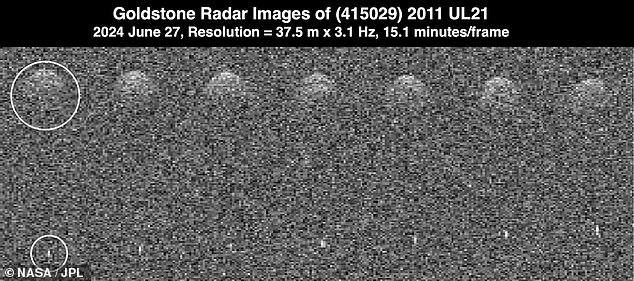A pair of “planet-destroying” asteroids — one recently discovered and one dragging along its own moon — were caught on video by NASA as they zoomed past Earth last week.
Scientists from the US space agency Jet Propulsion Laboratory (JPL) in the south California tracked and photographed the two monster space rocks using the 230-foot-wide Goldstone Solar System Radar, which also measured the dimensions of the objects.
Asteroid 2024 MK, first detected just 13 days before its closest approach to Earth, was determined to be an “elongated, angular” object 500 feet long, according to NASA radar that captured it skimming our planet on Saturday.
And asteroid 2011 UL21, a nearly mile-wide object that passed close to Earth on Thursday at 58,000 miles per hour, was seen with a “moon” orbiting about two miles above its surface.
Asteroid 2011 UL21 (top row), a nearly mile-wide object that passed close to Earth at 58,000 miles per hour, was photographed by NASA with a “moon” (bottom row) orbiting 1.9 miles above its surface.
The European Space Agency (ESA), which collaborates with NASA on planetary defence, has not minced words about the late identification of asteroid 2024 MK.
“An asteroid of this size would cause considerable damage,” ESA officials said.
“Therefore, its discovery just before the flyby highlights the continuing need to improve our ability to detect and monitor potentially hazardous near-Earth objects (NEOs),” the agency said.
First recorded on June 16 by the NASA-funded Asteroid Terrestrial-impact Last Alert System (ATLAS) in South Africa, the orbit of asteroid 2024 MK has now been altered by its incredibly close encounter with Earth’s gravitational pull.
The object came within a distance between Earth and the Moon’s orbit, coming within about 184,000 miles of the surface of our planet’s atmosphere.
While NASA classified 2024 MK as a “potentially hazardous asteroid,” NASA’s JPL reported that “calculations of its future motion show that it does not pose a threat to our planet in the foreseeable future.”
Dr. Lance Benner, a planetary scientist at JPL who helped lead the tracking of these two killer asteroids, said a true “near miss” like this one is unlikely to happen again for decades, and the U.S. space agency worked hard to make the most of it.

Asteroid 2024 MK (pictured) was first spotted just 13 days before its closest approach to Earth. NASA radar determined the space rock was an “elongated, angular” object 500 feet long.

The European Space Agency (ESA), which works with NASA on planetary defence, has not minced words regarding the late identification of asteroid 2024 MK (radar images above). “An asteroid of this size would cause considerable damage,” ESA officials said.
“This was an extraordinary opportunity to investigate the physical properties and obtain detailed images of a near-Earth asteroid,” said Dr. Benner.
2011 UL21, which orbits our Sun about once every 1,130 days, made its closest pass to planet Earth in more than a century with this recent flyby.
NASA’s JPL was able to determine that this nearly two-mile-wide planet-buster was “virtually spherical” thanks to its near-impact on June 27.
The very close, high-speed transit of 2011 UL21 also helped the Goldstone radar, also known as Deep Space Station 14 (DSS-14), discover its orbiting asteroid ‘moon.’
“About two-thirds of asteroids of this size are thought to be binary systems,” Dr. Benner said of the find.

Two “planet-destroying” asteroids – one discovered just two weeks ago and another dragging its own moon – have been captured on video by NASA as they zoomed past Earth.
“Their discovery is particularly important because we can use measurements of their relative positions to estimate their mutual orbits, masses and densities, which provide key information about how they may have formed,” he continued.
Like 2024 MK, NASA’s JPL reported that 2011 UL21 and the tiny moon that makes it a “binary system” are “potentially hazardous.”
In fact, 2011 UL21 is classified as a “planet killer,” according to Science Livewhich is defined as an asteroid capable of causing damage on a continental scale and capable of throwing enough debris on impact to cause significant climate changes.
“Calculations of its future orbits,” they noted, “show that it will not pose a threat to our planet in the foreseeable future.”
Scientists at the Massachusetts Institute of Technology revealed in 2023 that an asteroid of that category will not hit Earth for at least the next 1,000 years.


